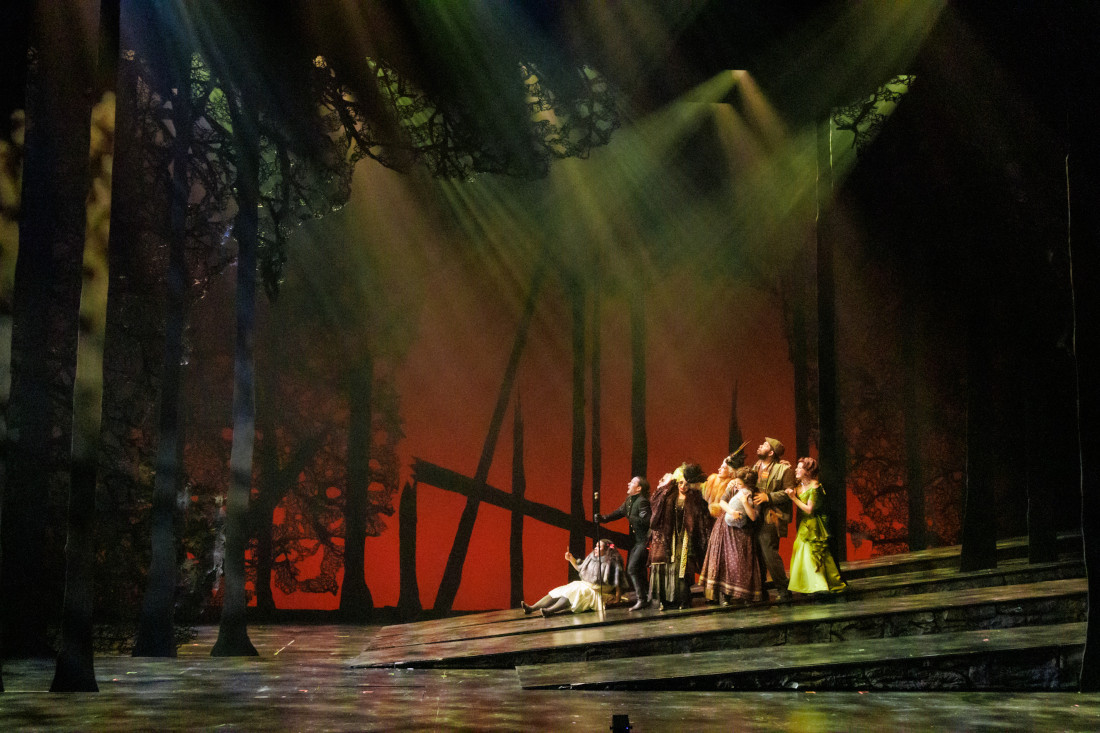When fairytales collide
Royal MTC retells the timeless teachings of Into the Woods
Cinderella meets Little Red Riding Hood meets a baker’s wife meets Jack and his beanstalk. Rapunzel does more than just let down her hair.
In Into the Woods, Stephen Sondheim’s musical with a book by James Lapine, characters from the world’s most-loved fairytales cross paths in an unlikely setting: the woods.
Running now until Feb. 4, it’s the Royal Manitoba Theatre Centre’s (Royal MTC) first musical since 2020, director Kelly Thornton tells The Uniter – and the timing couldn’t be better.
“This musical is so much about selfish pursuits versus communal responsibility,” Thornton says. “It’s totally a musical for our time.”
In the months leading up to opening night, Thornton knew the woods could not be stagnant. They had to be everchanging. Luckily, Gillian Gallow, the show’s set and costume designer, went above and beyond to align with that vision.
“I never want to be in the same place in the forest for very long. I want to go deeper and deeper into the woods,” Thornton says. “The woods is our journey into facing ourselves, which is really what they do.”
In the first act, the musical shifts in and out of several traditional characters’ worlds – Cinderella, Little Red Riding Hood and Rapunzel – until the narratives mingle in the woods. Familiar Brothers Grimm-style morals are affirmed, until they aren’t.
Sondheim had many inspirations, but a rather unconventional one was psychoanalyst Carl Jung. Throughout the play, the narrative fumbles with the fragile wires of the brains viewing the stage.
“It’s about moral responsibility – the responsibility you have in getting your wish not to cheat and step on other people’s toes, because it rebounds,” Sondheim said in a 1997 Paris Review interview with James Lipton. “The second act is about the consequences of not only the wishes themselves but of the methods by which the characters achieve their wishes, which are not always proper and moral.”
In the intermission, the audience wonders if the story will continue, as the emerald projection on the curtain proclaims. Fearing that audiences would accidentally flee, Thornton hoped the projection would convince viewers to stay the full three hours.
“I put ‘intermission,’ because I swore some people would just get up and think it was done,” Thornton says. “We’re so programmed. The two things that influence us are fairytales themselves, that happily ever after thing, but also the Hollywood movie structure where everything is tied up in a bow.”
Thornton argues the second half is where Sondheim’s tale truly gets its teeth. Soon after the 30-minute pause, chaos ensues. The happy-ending promise of childhood fairytales is shattered when a giant arrives on the scene, partially destroying the musical’s artfully-crafted sets.
Sondheim’s belief in the primitive power of fairytales is expertly readapted in MTC’s portrayal of the Giant, mastered by sound designer Chris Coyne. Never do we see the materialized Giant. It’s the existential threat that brings the characters closer together, testing the bounds of their solidarity.
“I know some other productions actually show manifestations of the Giant,” Thornton says. “But I don’t want to see it. I just want to hear it and imagine how scary that Giant really is.”
“I think (Coyne) did a great job. He certainly scares people, I think, with his sound.”
In addition to the Giant, the Royal MTC’s version of the musical has many elements that render it unique. Jillian Willems, the show’s choreographer, sought to develop an intricate movement language each character could use to carry the narrative.
“In my preparation, I developed some motifs that would repeat throughout the show,” Willems says. “They could be danced in different ways depending on where the characters were at on their respective journeys.”
Developing a visual language for the musical forced Willems to think a lot about space. During rehearsals, she and the cast pondered how to bring the more pedestrian scenes to life through movement. Actors were given a baseline number to work with but were free to add their personal flare.
While Willems says she enjoyed choreographing every step, slide and twirl along the way, the second act’s grand finale is a standout favourite for her.
“It’s the moment where they really connect with one another and truly acknowledge that together is the way to get through the woods,” Willems says. “It was kind of wonderful to be able to explore proximity to one another in that scene that we didn’t get to explore in the other numbers.”
In the intermingling of narratives in the woods, it’s the little things that count. Musically, Thornton says audiences will hear cues that reveal the show’s themes and motifs, even if they don’t realize it.
“The ‘bean theme’ is layered throughout the show,” she says, humming the tune. “Then (Sondheim) reverses the bean theme later in the show.”
When it comes down to it, the musical is a game of subconscious cues and endless fun. As a choreographer, Willems feels her job is to be as discreet as possible. That, however, doesn’t mean sacrificing technical prowess.
“I love when the dancing feels very organic and it feels like it’s coming from a really authentic and connected place,” Willems says. “My hope when people watch the show is that they won’t be able to tell where my work began and where Kelly’s work ended.”
Into the Woods has no shortage of lessons, but it strays from being preachy. In the building up and tearing down of happily ever after, audiences are given the autonomy to interpret their own ending.
“The best that theatre can do is leave us with a question, not an answer,” Thornton says.
The Royal MTC’s production of Into the Woods runs from now until Feb. 4. Tickets can be purchased via bit.ly/3Dgrmv9.
Published in Volume 77, Number 16 of The Uniter (January 26, 2023)







